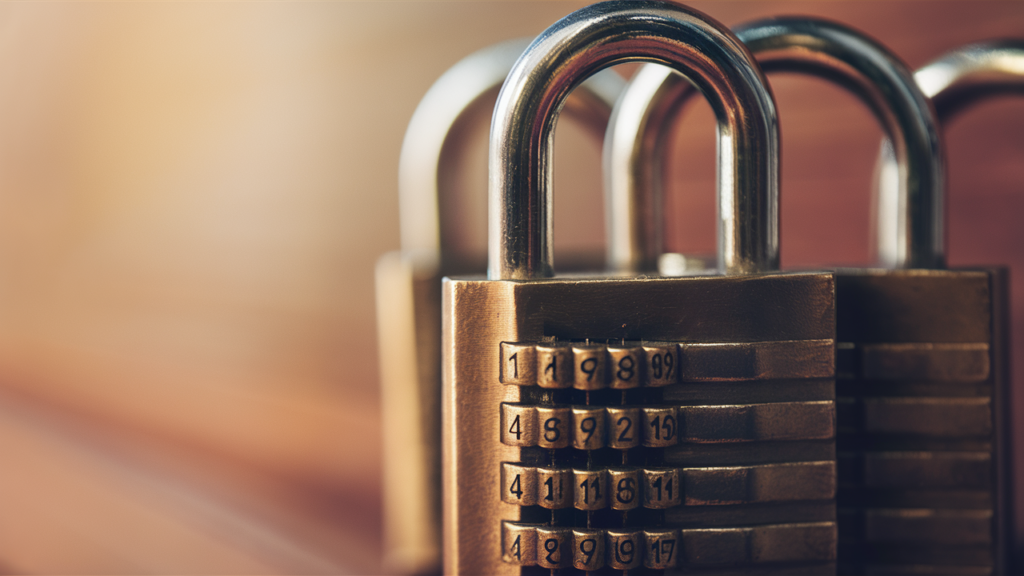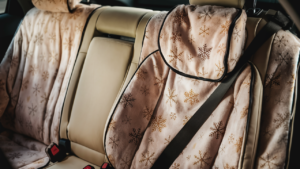A combination padlock works by aligning internal gears with a specific sequence of numbers. Turning the dial to these numbers releases the locking mechanism.
Recommended Best Smart Padlock 2025
| Recommendation | Product |
| Best Overall | eLinkSmart Heavy Duty Fingerprint Padlock |
| Popular Choice | Pothunder Fingerprint Padlock |
| Best Value | MEGAFEIS Smart Padlock with Keyless Biometric |
| Best Budget | eLinkSmart Fingerprint Padlock |
| Another Excellent Pick | igloohome New Smart Padlock 2 (SP2) |
Combination padlocks are popular for their simplicity and reliability. They use a rotating dial and a series of internal gears to secure items. Users must input a correct sequence of numbers to unlock the device. This type of lock is commonly used for lockers, gates, and storage units.
Unlike key locks, combination locks eliminate the risk of losing keys. Their design offers both security and ease of use, making them an ideal choice for various applications. Understanding how they function can help users choose the right lock for their needs and enhance their security measures effectively.
The Mechanics Behind Combination Padlocks
Understanding how combination padlocks work reveals their clever design. These locks use simple mechanical principles to secure belongings. Let’s explore their key components and how they function together.
Components Of A Combination Lock
Combination padlocks consist of several important parts:
- Dial: The circular part you turn.
- Gear: Connects the dial to the locking mechanism.
- Locking Pins: Keep the lock secure when not aligned.
- Shackle: The part that opens to release the lock.
Each component plays a vital role in the locking process. Their interaction ensures security and ease of use.
The Role Of The Dial In Security
The dial is the heart of the combination lock. Users input a specific sequence of numbers. Here’s how it works:
- Turn the dial to the right to the first number.
- Turn it left to the second number.
- Finally, turn it right again to the last number.
This sequence aligns the locking pins. Once aligned, the shackle releases. Without the correct numbers, the lock remains secure.
Understanding these mechanics helps users appreciate the security combination padlocks offer. They combine simplicity with effective protection.
History And Evolution Of Padlocks
Padlocks have a rich history. They date back thousands of years. Their design has changed significantly over time. Today, they play a crucial role in security.
From Ancient Times To Modern Security
Padlocks have existed since ancient civilizations. Here’s a brief timeline:
| Era | Key Developments |
|---|---|
| Ancient Egypt | Wooden locks with simple key mechanisms. |
| Ancient Rome | Metal locks with more complex designs. |
| Middle Ages | Introduction of the first combination locks. |
| Industrial Revolution | Mass production of padlocks for homes and businesses. |
| Modern Era | Smart locks and electronic padlocks. |
Each era brought innovations. People sought better security solutions. Today, padlocks protect everything from homes to sensitive data.
Technological Advancements In Lock Design
Technological progress transformed padlocks significantly. Here are key advancements:
- Materials: Transition from wood to durable metals.
- Complexity: Combination locks replaced simple keys.
- Smart Technology: Bluetooth and biometric locks emerged.
Modern padlocks offer enhanced security features. Users can control access remotely. This evolution improves safety in daily life.
Understanding this history shows how far we’ve come. Padlocks will continue to evolve with technology.
Setting And Resetting A Combination
Understanding how to set and reset a combination lock is crucial. This ensures your belongings stay secure. Follow these steps for a smooth experience.
Initial Setup Of A New Lock
Setting up a new combination padlock is simple. Follow these steps:
- Open the lock using the factory preset code.
- Locate the reset lever or button.
- Move the lever to the reset position.
- Choose your desired combination.
- Return the lever to its original position.
- Test the new combination to confirm.
Remember to write down your new combination. Store it in a safe place.
Changing Your Code For Enhanced Security
Changing your combination improves security. Follow these easy steps:
- Open the lock with the current code.
- Find the reset lever or button.
- Switch it to the reset position.
- Enter your new combination.
- Return the lever to the original position.
- Test the new code to ensure it works.
Regularly changing your code keeps your items safe. Make it a habit to update your combination.
The Science Of Sequential Codes
Understanding how a combination padlock works involves grasping the science of sequential codes. These codes are not random; they follow a specific order. This order is crucial for unlocking the padlock. Each number in the sequence must align perfectly with the lock’s internal mechanism.
How Combination Sequences Work
A combination sequence consists of several numbers. These numbers must be entered in the correct order. Here’s how it works:
- Turn the dial to the right to the first number.
- Turn the dial to the left to the second number.
- Finally, turn the dial to the right again to the last number.
Each number corresponds to a specific notch inside the lock. When aligned, these notches allow the lock to open.
Why Order Matters In Lock Security
The order of numbers in a combination is vital. A small change can prevent the lock from opening. Here are key reasons why order matters:
- Security: The correct sequence enhances security.
- Complexity: More numbers increase the combination’s complexity.
- Protection: Incorrect order protects against unauthorized access.
For example, a lock with three digits has 1,000 possible combinations. Each sequence must be precise to unlock.
Understanding this science helps users choose secure combinations. It also aids in maintaining lock security.
Common Types Of Combination Locks
Combination locks come in various types. Each type has unique features. Understanding these types helps in choosing the right lock for your needs. Here are the most common types:
Single-dial Locks
Single-dial locks are the most popular type. They have a single rotating dial. Users enter a sequence of numbers to unlock.
- Easy to use
- Commonly found on lockers
- Available in different security levels
To unlock a single-dial lock:
- Rotate the dial to the first number.
- Turn it to the second number.
- Finally, turn it to the third number.
Multiple-dial Locks
Multiple-dial locks use more than one dial. Each dial has its own number to input. This adds an extra layer of security.
- Higher security than single-dial locks
- Common on safes and high-security doors
- More complex to use
Unlocking a multiple-dial lock involves:
- Turning each dial to the correct number.
- Following the specific order for each dial.
Both types have their advantages. Choose based on your security needs.
Troubleshooting Common Issues
Combination padlocks are reliable but can face issues. Knowing how to troubleshoot helps you regain access. Here are common problems and their solutions.
Stuck Locks And Jammed Dials
A stuck lock or jammed dial can be frustrating. Follow these steps to fix the issue:
- Inspect the Lock: Look for dirt or debris. Clean the lock with a cloth.
- Lubricate the Dial: Use a graphite lubricant. Avoid oil-based products.
- Check the Alignment: Ensure the dial is aligned properly. Misalignment can cause jamming.
If these steps do not work, try this method:
| Step | Action |
|---|---|
| 1 | Gently pull the shank while rotating the dial. |
| 2 | Continue to turn the dial slowly. |
| 3 | Keep trying until the lock opens. |
Forgotten Combinations And Resets
Forgetting a combination can be stressful. Here’s how to reset your lock:
- Locate the Reset Tool: Check if your lock came with a reset tool.
- Follow the Instructions: Each lock has specific instructions.
- Contact the Manufacturer: They can provide assistance.
Prevent future issues:
- Write down the combination in a secure place.
- Use a password manager for digital storage.
- Change the combination periodically for security.
Stay proactive to avoid frustrations with your combination padlock.
Enhancing Security With Combination Locks
Combination locks offer a robust way to secure your belongings. They rely on a specific sequence of numbers to open. This feature makes them harder to crack than traditional locks. Their design helps prevent unauthorized access effectively. Understanding how to use them correctly boosts your security.
Best Practices For Lock Use
- Choose a Unique Code: Avoid common combinations like “1234.” This reduces the chance of someone guessing your code.
- Change Your Code Regularly: Update your combination every few months. This keeps your lock secure.
- Keep It Confidential: Do not share your code with others. This limits who can access your lock.
- Test Your Lock: Regularly check if your combination works smoothly. Ensure no mechanical issues arise.
- Store the Code Safely: Write it down but keep it hidden. Avoid placing it near the lock.
Choosing The Right Lock For Your Needs
Selecting the perfect combination lock is crucial. Different locks serve various purposes. Here’s a simple table to guide your choice:
| Type of Lock | Best For | Security Level |
|---|---|---|
| Padlock | Sheds, garages | Medium |
| Wall-Mounted Lock | Gates, fences | High |
| Bike Lock | Bicycles | Medium |
| Lock Box | Keys, valuables | High |
Consider these factors:
- Purpose: Identify what you need to secure.
- Durability: Look for materials that withstand the elements.
- Locking Mechanism: Choose between dial or digital options.
- Size: Ensure the lock fits your application.
The Future Of Lock Technology
The landscape of lock technology is changing rapidly. New innovations enhance security and convenience. Combination padlocks are evolving to meet modern needs.
Innovations In Digital Locking Systems
Digital locks are gaining popularity. They offer features traditional locks can’t match. Here are some key innovations:
- Smart Locks: These locks connect to smartphones. Users can unlock doors remotely.
- Keyless Entry: No physical keys are needed. Users enter codes or use apps.
- Remote Monitoring: Users can check lock status from anywhere. Alerts notify users of unauthorized access.
| Feature | Traditional Locks | Digital Locks |
|---|---|---|
| Physical Key Required | Yes | No |
| Remote Access | No | Yes |
| Custom Codes | No | Yes |
Biometrics And Beyond
Biometric locks are the next big thing. They use unique traits for access. Common biometric methods include:
- Fingerprint Scanning: Uses fingerprints for secure access.
- Facial Recognition: Scans faces to grant entry.
- Iris Scanning: Uses eye patterns for identification.
These systems offer high security. They are hard to bypass compared to keys. The future holds even more exciting possibilities.
- Integration with smart home systems
- Advanced encryption for data protection
- Improved user interfaces for ease of use

Frequently Asked Questions
How Does A Combination Padlock Unlock?
A combination padlock unlocks by aligning internal gears to match a preset sequence. When you turn the dial, it rotates a series of discs or wheels inside. Each number you input moves these components, ultimately allowing the shackle to release when all numbers align correctly.
What Are The Parts Of A Combination Padlock?
A combination padlock consists of several key parts: the dial, locking mechanism, and shackle. The dial is what you turn to input the combination. Inside, gears and levers work together to secure the lock. The shackle is the metal loop that opens when the correct combination is entered.
How Do You Set A Combination Padlock?
To set a combination padlock, first, open it using the default combination. Then, locate the reset mechanism, usually a lever or button. Follow the instructions to input your desired combination and confirm it. Finally, test the new combination before locking it again to ensure it works properly.
Can You Reset A Combination Padlock?
Yes, you can reset a combination padlock, but only if you know the current combination. Most padlocks have a reset feature that requires opening the lock first. Once open, follow the manufacturer’s instructions to change the combination and ensure you remember the new sequence for future use.
Conclusion
Understanding how a combination padlock works can enhance your security knowledge. These locks use a simple mechanism that relies on rotating discs. Each combination aligns the discs, allowing the lock to open. By mastering this concept, you can choose the right padlock for your needs and ensure your belongings are safe.








